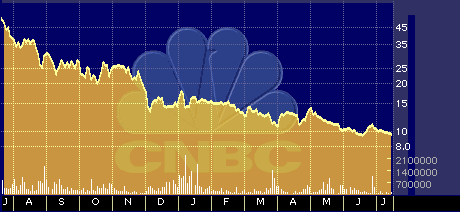
More Gains Seen for Keynote Systems
More Gains Seen for Keynote Systems
by Hal Plotkin
Silicon Valley Correspondent
“I believe they’re in on the beginning of a very big boom. I’m amazed people haven’t been jumping up and down about it.”
— Bill Glassman, senior analyst at the Gartner Group
Several analysts say Keynote Systems Inc.’s {KEYN} stock should continue to rise, thanks to the company’s leadership in measuring how quickly customers can get access to Web sites.
“I believe they’re in on the beginning of a very big boom,” says Bill Gassman, senior analyst at the Gartner Group, based in Amherst, N.H. “I’m amazed people haven’t been jumping up and down about it.”
Although investors may not be jumping up and down, Keynote’s stock has done quite well since its initial public offering in September, which was priced at $14 a share.

Post-IPO chart for KEYN
The stock moved up again sharply on Monday, after Dain Rauscher Wessels analyst Stephen Sigmond reiterated his “buy-speculative” rating and raised his 12-month price target to $70. His previous target for the stock, set at the beginning of November, was $50.
“Our 12-month price target is based on a cash-flow analysis of projected 2003 earnings, using a 25 percent discount rate similar to early-stage Internet infrastructure companies,” Sigmond wrote in his most-recent report.
San Mateo, Calif.-based Keynote is, among other things, the leading provider of a service that tells Web-site operators how long it takes customers to access their site from different locations around the globe. The company has remote monitoring stations in 220 different locations and plans to expand that number to 400 in the next few years.
“A key to our success is our reputation as a trusted, independent, third-party,” said John Flavio, Keynote’s chief financial officer, at a recent industry meeting in San Francisco.
Jack Ripstein, an analyst at Hambrecht & Quist, based in San Francisco, says he likes Keynote’s position as a leader in the online quality-of-service market.
“Customer service is going to be one of the most-important things moving forward,” Ripstein says. “If your Web site doesn’t load quickly, or doesn’t perform, that’s tantamount to slamming the door in a customer’s face in the brick-and-mortar world.”
Ripstein also rates the stock “buy,” which is his firm’s top rating. H&Q hasn’t set a price target for the stock.
Ripstein, like other analysts, says the importance of Keynote’s service is emphasized by recent data on the growing impatience of Web surfers. Most users, for example, will click away from a Web site after an eight-second delay, according to Zona Research, based in Redwood City, Calif. “Performance is equal to quality is equal to revenue,” Flavio says.
As is the case in many other Internet-business areas, assessing the size of Keynote’s overall market opportunity is a bit tricky, because the opportunity is relatively new.
“The most-direct indicator of Keynote’s market potential is the overall growth in the number of Web sites or, more specifically, the number of URLs,” wrote Hambrecht & Quist analyst Daniel Rimer in a recent research report. “Since Keynote charges for its service on a per-URL basis, we believe total growth in URLs is a good proxy for
Keynote’s opportunity. It is estimated that the number of URLs will grow to 13.1 billion by 2003, up from 925 million in 1998. Currently, Keynote measures fewer than 10,000 URLs. Hence, the opportunity for growth is wide open.”
| KEYNOTE SYS INC NNM:KEYN) | |
| Analyst
Opinions |
|
| Strong Buy | 0 |
| Buy | 3 |
| Hold | 0 |
| Sell | 0 |
| Strong Sell | 0 |
| Click here to view the full analyst report. | |
Click here to view the full analyst report.
Keynote’s customers include 80 percent of the top 50 Web sites and nearly 40 percent of the top 500 Web sites listed by New York-based Media Metrix. Those customers include Amazon.com Inc., Charles Schwab Corp., Cisco Systems Inc., Dell Computer Corp., and Hewlett-Packard Co., according to data provided by the company.
More important, Keynote enjoys a 98 percent customer-renewal rate, according to Flavio.
“You’re talking about a recurring revenue model,” Ripstein says. “It’s important because it becomes an annuity. You can count on it on an annualized basis.”
The strong customer-renewal rate also helps Keynote protect its market and expand the services offered to clients. In addition to finding out how quickly their own Web site performs, for example, customers can also benchmark their performance against other companies in their industry.
“That’s the kind of information you really need,” Gassman says. “It gives a business tools to negotiate service levels with their Internet Service Provider.”
Keynote’s closest competitor, Boulder, Colo.-based Service Metrics Inc., was acquired by Exodus Communications Inc. {EXDS}, a Web-hosting firm based in Santa Clara, Calif., late last month for about $280 million in stock. The acquisition gives Exodus customers access to services similar to those provided by Keynote. The relative size of the respective operations, however, still leaves Keynote in the lead; Service Metrics makes 1.5 million Web-performance measurements a day, compared with more than 12 million for Keynote.
“Keynote is clearly No. 1,” Gassman says. “But the amount paid for Service Metrics gives you an indication of the value of this kind of company.”
On Oct. 26, Keynote posted a fiscal fourth-quarter loss of $3.5 million on revenue of $3.2 million, representing a revenue increase of 435 percent over the same quarter a year earlier when the company had a loss of about $1 million.


